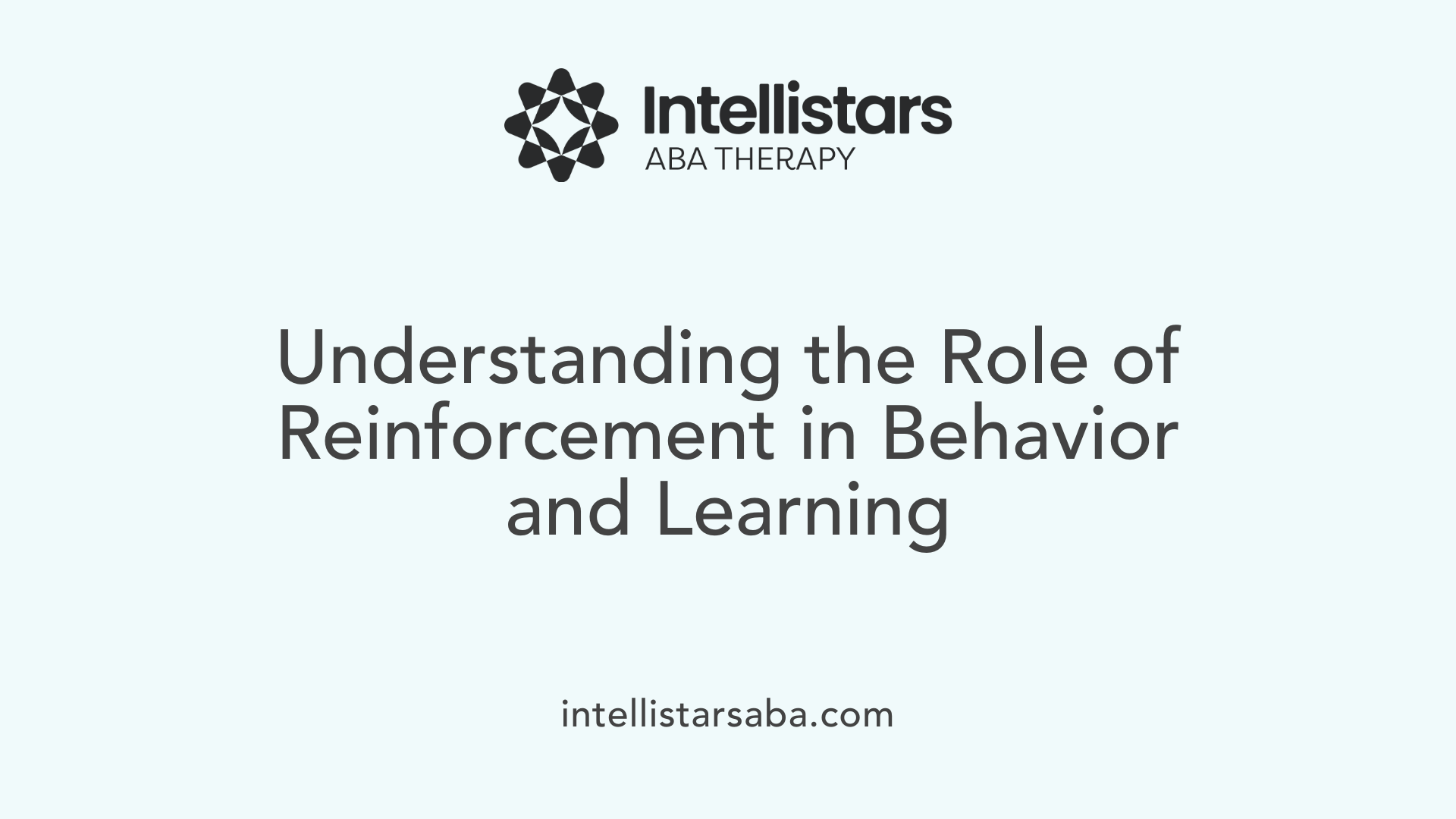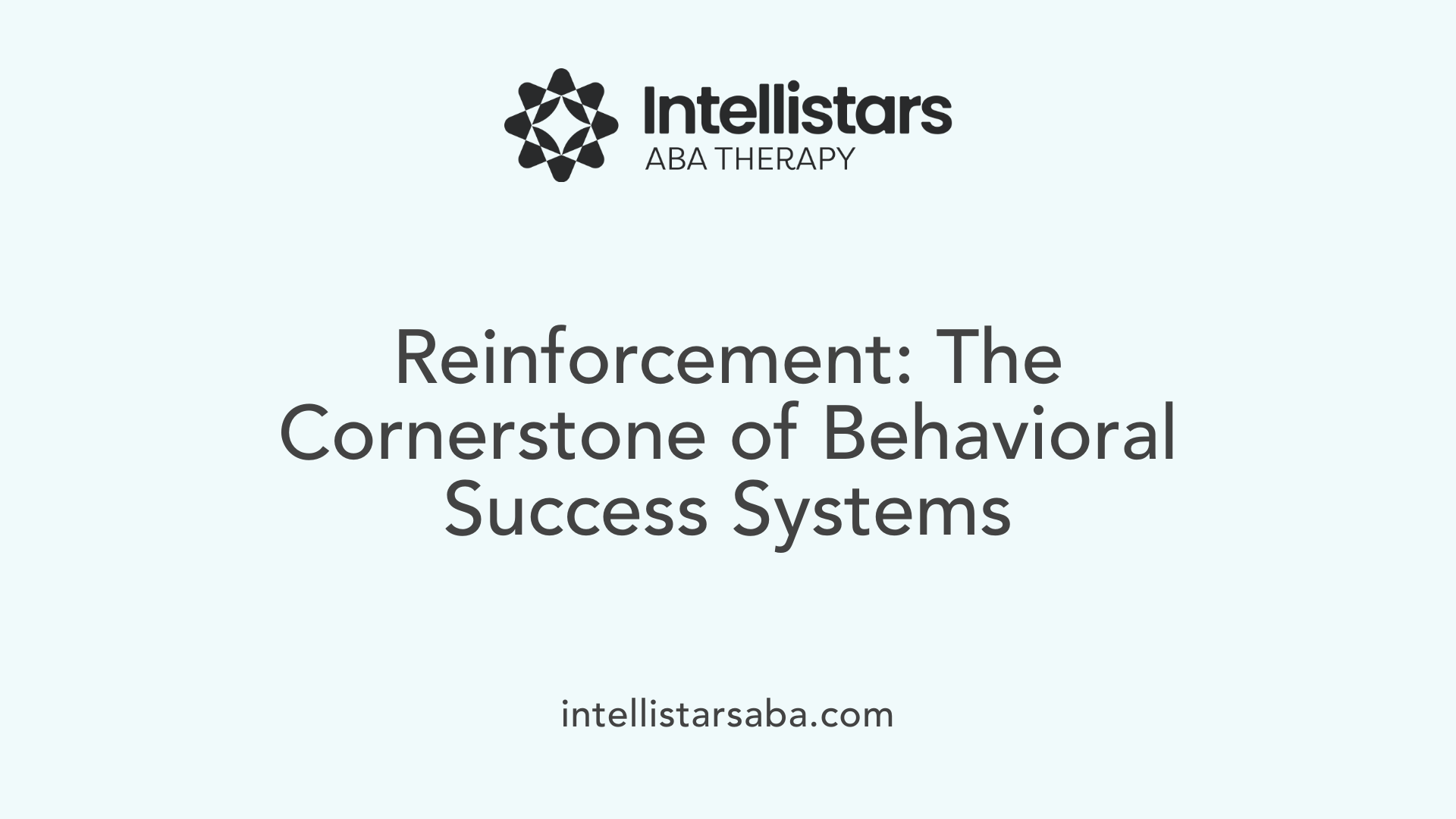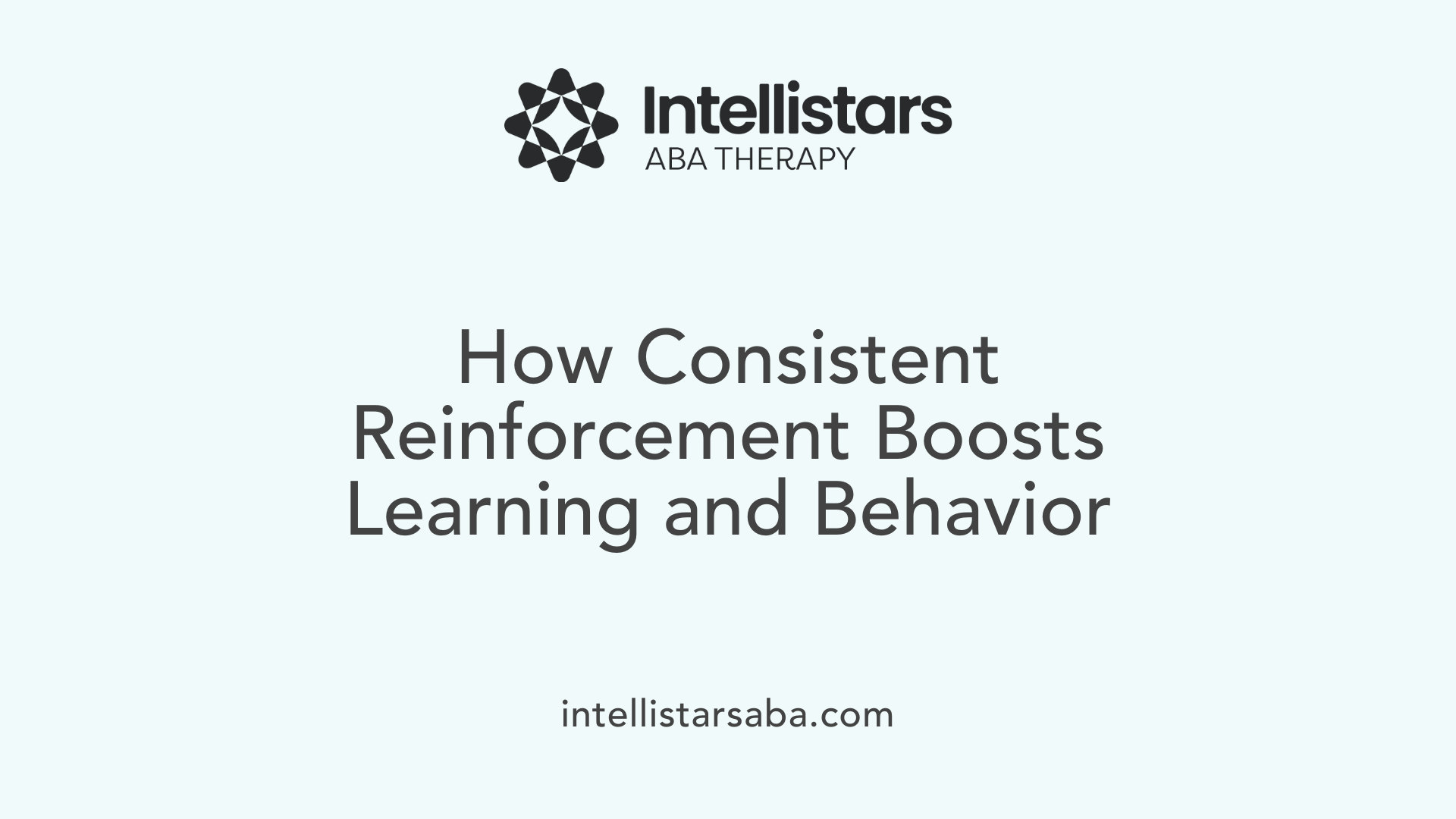The Critical Role of Consistency in Reinforcement
Reinforcement is a fundamental principle in shaping behaviors, especially in children’s learning and development. When reinforcement is consistent across different environments—home, school, therapy settings—it creates a predictable, stable framework that supports behavioral growth and skill transfer. This article explores the importance of maintaining consistent reinforcement, effective strategies for implementation, and its profound impact on individuals, particularly children with autism. Harnessing structured routines, visual cues, and collaborative efforts ensures reinforcement effectiveness, fostering positive outcomes for learners of all ages and abilities.
Understanding Reinforcement in Behavior and Learning

What is the role of continuous reinforcement in the learning process?
Continuous reinforcement involves providing a reward or consequence immediately after a desired behavior occurs every time. This approach plays a vital role during the initial stages of learning by establishing a strong link between the behavior and its positive outcome.
When learners consistently receive reinforcement, they are more motivated to repeat the behavior, which accelerates skill acquisition. This method helps children or individuals understand exactly what actions lead to positive results, making it easier to form new habits.
In behavior change models like the COM-B framework—for Capability, Opportunity, Motivation—continuous reinforcement significantly influences motivation, encouraging learners to practice behaviors repeatedly.
However, once a behavior is well-established, switching from constant to intermittent reinforcement can help maintain the behavior over the long term without fostering dependence on rewards. This transition supports durable learning and helps prevent the extinction of the desired behaviors.
Why is reinforcement consistency important in behavioral programs like PBIS and ABA therapy?
Reinforcement consistency is crucial because it helps children and learners understand what to expect, creating a stable environment for growth. Programs such as Positive Behavioral Interventions and Supports (PBIS) and Applied Behavior Analysis (ABA) rely heavily on consistent reinforcement strategies.
When reinforcement is applied regularly and uniformly across settings—whether at home, in school, or in therapy—learners are more likely to generalize skills, using them in various contexts. This reduces confusion and anxiety, supporting emotional regulation and independence.
Consistent reinforcement also ensures that desired behaviors are strengthened over time, preventing regression and promoting long-term development. It allows caregivers, teachers, and therapists to build predictable routines, making it easier for children to internalize expectations and adapt behaviors accordingly.
Furthermore, reliable reinforcement fosters trust and a positive relationship between the child and the adult, empowering children to participate actively in their learning process. Ultimately, maintaining consistency across environments leads to better intervention outcomes, smoother behavior transitions, and stronger skill retention.
The Impact of Consistency on Behavior and Skill Generalization

How does reinforcement consistency support children’s learning and development, including those with autism?
Reinforcement consistency is fundamental in shaping positive behaviors and facilitating learning in children. When feedback and rewards are predictable, children develop a clear understanding of expectations, which helps in acquiring new skills. This consistency is especially vital for children with autism, as structured routines and uniform behavioral responses reduce their anxiety and make learning environments safer.
Applying reinforcement strategies uniformly across different settings—such as at home, school, or in therapy—enhances the transfer of skills from one context to another. For example, a child who receives praise for sharing toys at school is more likely to demonstrate sharing at home if reinforcement is consistent.
Maintaining stable routines and applying behavior management techniques consistently also prevent regressions, promote emotional stability, and foster confidence. When children know what to expect and see their efforts rewarded reliably, they build trust in their environment, which encourages independence and better self-regulation.
Overall, reinforcement consistency not only accelerates skill development but also supports long-term emotional resilience and social competence, especially for children with developmental challenges. It creates a predictable, supportive environment where children feel secure and motivated to learn and grow.
Strategies for Implementing Reinforcement Across Multiple Settings
 Creating a consistent environment where reinforcement is applied uniformly across different settings is essential for promoting positive behaviors and ensuring that children understand expectations. Several strategies can help achieve this consistency.
Creating a consistent environment where reinforcement is applied uniformly across different settings is essential for promoting positive behaviors and ensuring that children understand expectations. Several strategies can help achieve this consistency.
Structured routines and visual cues play a critical role in maintaining reinforcement practices. Visual supports such as schedules, timers, and symbols serve as external prompts, guiding children and adults through expected behaviors. These tools reduce ambiguity, especially for children with developmental challenges, by providing predictable cues about when and how reinforcement occurs. Establishing clear routines helps solidify behavioral expectations, making it easier for everyone involved—teachers, caregivers, and therapists—to apply reinforcement protocols uniformly. When routines are consistently supported with visual cues, they foster a sense of stability, which enhances response reliability and skill generalization.
Caregiver and educator training is paramount for successful implementation. Training programs should focus on teaching stakeholders how to recognize target behaviors, deliver immediate and appropriate reinforcement, and avoid inconsistencies that can undermine progress. When caregivers and educators are well-trained, they can maintain consistent reinforcement schedules and adapt strategies to different environments and individual needs. Ongoing professional development ensures that reinforcement techniques are current and aligned with best practices, thereby strengthening the overall behavior change efforts.
Consistent protocols and communication are vital for sustaining reinforcement across settings. Developing clear, written reinforcement protocols helps ensure everyone understands the methods and timing for reinforcement delivery. Regular communication among teachers, caregivers, and specialists fosters shared understanding and accountability. Utilizing tools like shared behavior logs or digital platforms can support this communication, allowing for real-time updates and feedback. This collaborative approach not only maintains consistency but also helps identify and address challenges promptly.
Incorporating these strategies within a behavior change framework—such as the COM-B model, which emphasizes capability, opportunity, and motivation—ensures that reinforcement efforts are targeted, adaptable, and sustainable across diverse environments. When all stakeholders understand and commit to these practices, children receive consistent reinforcement, which strengthens learning and social-emotional development.
The Role of Reinforcement in Behavior Management Systems like PBIS and ABA

Why is consistency vital in behavioral programs such as PBIS and ABA therapy?
Consistency plays a crucial role in effective behavior management systems like Positive Behavioral Interventions and Supports (PBIS) and Applied Behavior Analysis (ABA). When behavioral strategies, including reinforcement, are applied consistently across different settings and by all caregivers, children develop a clear understanding of what is expected of them.
A stable and predictable environment helps reduce confusion and anxiety, which is especially important for children with behavioral challenges or developmental disorders. Regular routines, clear expectations, and immediate reinforcement create a sense of order that supports emotional stability and confidence.
Furthermore, consistent reinforcement ensures that learned skills are generalized across various contexts, such as home, school, and community. This continuity helps children apply their new skills independently in different situations.
Another benefit of consistency is the prevention of skill regression. When behaviors are reinforced regularly, children are more likely to maintain and strengthen positive behaviors over time.
In summary, consistency builds a supportive framework that accelerates progress and promotes long-term success in behavior management. It fosters trust and security, crucial for fostering resilience, self-regulation, and social competence.
Benefits of Reinforcement Consistency in Educational and Behavioral Contexts

Why is consistency important in reinforcement and behavior management?
Maintaining consistency in reinforcement and behavior strategies is vital for creating a stable and predictable environment for learners. When teachers and caregivers apply the same rules and responses regularly, students understand exactly what is expected of them and the consequences of their actions. This clarity encourages positive behaviors and helps students develop self-control and responsibility.
Consistent reinforcement fosters trust between students and adults, which boosts motivation and confidence. It also reduces confusion and anxiety, particularly for children who thrive on routine, such as those with autism. For example, when praise or rewards are immediate and uniform across different settings—home, school, or therapy—it becomes easier for children to generalize their learning.
In today's educational landscape, which often features hybrid learning models and the integration of AI technology, consistency remains essential. It provides a stable framework that accommodates ongoing changes and maintains a positive, supportive atmosphere. Uniform responses and expectations across environments help students adapt and continue their progress without setbacks.
Ultimately, consistent reinforcement builds a solid foundation for academic achievement, behavioral improvements, and social-emotional growth. It supports children in developing lasting skills that are essential for their success and well-being.
Practical Tips for Ensuring Reinforcement Consistency
 Maintaining reinforcement consistency across multiple environments is crucial for reinforcing positive behaviors and promoting steady progress, especially for children with special needs. One practical approach is to establish clear routines supported by visual cues such as schedules, charts, and timers. These tools help children understand what to expect, reduce anxiety, and provide a predictable framework for behavior reinforcement.
Maintaining reinforcement consistency across multiple environments is crucial for reinforcing positive behaviors and promoting steady progress, especially for children with special needs. One practical approach is to establish clear routines supported by visual cues such as schedules, charts, and timers. These tools help children understand what to expect, reduce anxiety, and provide a predictable framework for behavior reinforcement.
Another essential aspect is involving all caregivers—parents, teachers, therapists—in training. Consistent application of reinforcement strategies by everyone ensures that behaviors are reinforced uniformly, which helps with generalization of skills across settings. Regular communication among involved parties fosters collaboration and allows for adjustments based on ongoing observations.
Using standardized behavior management practices, like applying the same reinforcement protocols and responses, creates stability. This predictability reassures the child and helps embed desired behaviors. Incorporating sensory-friendly environments and coping mechanisms further supports the child’s comfort, making reinforcement more effective.
Regular progress monitoring through data collection plays a vital role. Systematic tracking of behaviors helps identify trends, measure milestones, and determine whether reinforcement strategies are effective. This informs timely modifications, preventing stagnation and ensuring that interventions remain tailored to the individual’s evolving needs.
Involving caregivers consistently ensures reinforcement is reinforced beyond the classroom or therapy session, creating a unified support system. This alignment strengthens the learning environment, fostering lasting behavior change.
In summary, combining visual routines, comprehensive training, regular communication, and diligent data monitoring creates a robust framework for reinforcement consistency, which underpins successful behavior management and development.
Conclusion: Building a Culture of Consistent Reinforcement
 Embedding reinforcement into the core of an organization’s culture is essential for fostering long-term positive behaviors. When reinforcement strategies are consistently applied across all levels of a school or organization, it creates an environment of trust and predictability. This stability helps learners and members understand expectations clearly, which is crucial for developing habits that support academic achievement, social-emotional development, and overall well-being.
Embedding reinforcement into the core of an organization’s culture is essential for fostering long-term positive behaviors. When reinforcement strategies are consistently applied across all levels of a school or organization, it creates an environment of trust and predictability. This stability helps learners and members understand expectations clearly, which is crucial for developing habits that support academic achievement, social-emotional development, and overall well-being.
Sustainability of positive behaviors hinges on ongoing reinforcement efforts that are integrated into everyday routines and interactions. Consistent application of praise, rewards, and corrective feedback ensures that behaviors are ingrained and transferred across different settings such as home, school, and community. Collaboration among teachers, parents, caregivers, and students plays a pivotal role in maintaining this consistency, as shared expectations reinforce the learning process.
Leadership and continuous development are vital components in cultivating a reinforcement-rich environment. School leadership must model consistent behavior management practices, establish clear policies, and provide ongoing training to staff. Professional development programs focusing on positive reinforcement, behavior management, and social-emotional learning help teachers stay current with effective strategies. This sustained effort encourages a growth mindset, resilience, and emotional regulation among students.
Creating an organizational culture that values positive reinforcement involves establishing routines, visual cues, and incentive systems that motivate and guide behavior effectively. For instance, token economy systems, praise, and peer modeling are practical tools that promote desired behaviors. When these methods are applied consistently, they contribute to a supportive climate that nurtures both academic success and social skills.
Moreover, reinforcing positive behaviors at all levels fosters a sense of community and shared responsibility. It encourages learners to take ownership of their actions, develop self-regulation skills, and build confidence. Long-term, this approach supports the evolution of a nurturing environment where positive behaviors become embedded in the organizational identity.
Regular monitoring of reinforcement strategies through data collection and feedback ensures continual improvement. Adjustments based on this data help maintain the relevance and effectiveness of reinforcement efforts, preventing stagnation. Engaging leadership in analyzing progress facilitates strategic planning and resource allocation, ensuring that positive behaviors are sustained and amplified.
In essence, a strategic, consistent approach to reinforcement, supported by committed leadership and ongoing professional growth, lays the foundation for a resilient and adaptive learning environment. This culture not only promotes immediate behavioral improvements but also prepares individuals to thrive independently and collaboratively in diverse settings.
Fostering Long-Term Success Through Consistency
Establishing and maintaining consistent reinforcement across environments is not merely a technique but a foundational strategy for long-term success. It fosters a predictable, stable environment where skills can be reliably generalized, behaviors are understood, and emotional well-being is promoted. For educators, therapists, and caregivers, adopting structured routines, visual cues, and collaborative reinforcement strategies ensures that positive behaviors are ingrained into daily routines, encouraging resilience and independence. The ongoing commitment to consistency, supported by data monitoring and leadership, helps embed reinforcement into the culture of educational and behavioral programs. Doing so guarantees not only immediate improvements but also sustainable growth, empowering individuals to thrive across life’s many settings.
References
- Why Consistency is Important in Classroom Behavior Management
- Reinforcement in the Classroom: Positive Learning Environments
- The Importance of Consistency in ABA Therapy: How Routine Builds ...
- Reinforcement in ABA: Key Principles and How They Work
- Positive Behavior: Effective Strategies for Reinforcement and Rewards
- Positive Reinforcement and Operant Conditioning - Verywell Mind
- Using Positive Reinforcement for High-Need Children
- The Satchel Pulse Blog | School Culture
- Why it Matters: Consistency in ABA Therapy
- Why Consistent ABA Services Are Essential? - Clinical Behavior






